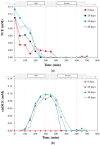A Polyhydroxybutyrate (PHB)-Biochar Reactor for the Adsorption and Biodegradation of Trichloroethylene: Design and Startup Phase
- PMID: 35621470
- PMCID: PMC9137886
- DOI: 10.3390/bioengineering9050192
A Polyhydroxybutyrate (PHB)-Biochar Reactor for the Adsorption and Biodegradation of Trichloroethylene: Design and Startup Phase
Abstract
In this work, polyhydroxy butyrate (PHB) and biochar from pine wood (PWB) are used in a mini-pilot scale biological reactor (11.3 L of geometric volume) for trichloroethylene (TCE) removal (80 mgTCE/day and 6 L/day of flow rate). The PHB-biochar reactor was realized with two sequential reactive areas to simulate a multi-reactive permeable barrier. The PHB acts as an electron donor source in the first "fermentative" area. First, the thermogravimetric (TGA) and differential scanning calorimetry (DSC) analyses were performed. The PHB-powder and pellets have different purity (96% and 93% w/w) and thermal properties. These characteristics may affect the biodegradability of the biopolymer. In the second reactive zone, the PWB works as a Dehalococcoides support and adsorption material since its affinity for chlorinated compounds and the positive effect of the "coupled adsorption and biodegradation" process has been already verified. A specific dechlorinating enriched culture has been inoculated in the PWB zone to realize a coupled adsorption and biodegradation process. Organic acids were revealed since the beginning of the test, and during the monitoring period the reductive dichlorination anaerobic pathway was observed in the first zone; no chlorinated compounds were detected in the effluent thanks to the PWB adsorption capacity.
Keywords: Dehalococcoides; biochar; bioremediation; polyhydroxy butyrate; reductive dechlorination.
Conflict of interest statement
The authors declare no conflict of interest.
Figures











References
-
- Mackay D.M., Cherry J.A. Groundwater contamination: Pump-and-treat remediation. Environ. Sci. Technol. 1989;23:630–636. doi: 10.1021/es00064a001. - DOI
-
- McGregor R. Distribution of Colloidal and Powdered Activated Carbon for theIn Situ; Treatment of Groundwater. J. Water Resour. Prot. 2020;12:1001–1018. doi: 10.4236/jwarp.2020.1212060. - DOI
LinkOut - more resources
Full Text Sources

